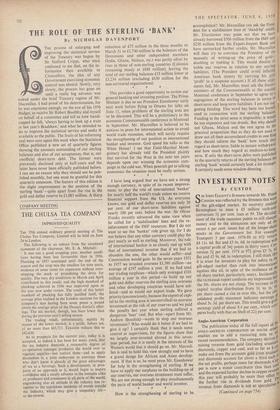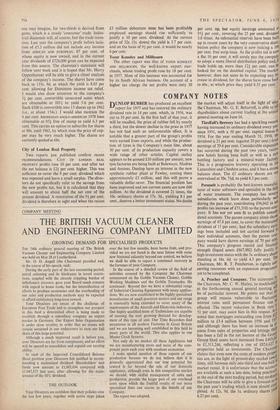INVESTMENT NOTES
By CUSTOS
SIR JOHN Eworr's firmness towards Mr. Frank Cousins was reflected by the firmness this weci, of the gilt-edged market. Its recovery enabler Birmingham to issue a £5 million cash-and' conversion 5f per cent. loan at 99. The develop. ment of the trade recession points to still cheaper money and to the attractions not only of recent 6 per cent. issues but of the longer-date u stocks in the Government list. For examPle' Transport 3 per cent. 1978-88 at 65* return'
;th
£4 11s. 6d. flat and £5 6s. 6d. to redemption vb.' a capital profit of 341- points in thirty years. COo' version 51 per cent. 1974 at 971 gives £5 7s. 6d,• flat and £5 9s. 6d. to redemption. I still think that it is wiser for investors to play for safety in dig, gilt-edged market than rush into internations' equities like oil, in spite of the resilience of the oil share market, particularly SHELL. IncidentallY; the ULTRAMAR report confirms my impression that the 10s. shares are not cheap. The increase in the capital surplus distribution from lg. to Is. per share caused a rise to over 68s., but the cow, solidated profit statement indicates earnings about 3s. 3d. per share net. This would give a ge°55 earnings yield of about 8.4 per cent., which eolir pares badly with that on Shell of 22-1 per cent.
Anglo-American Corporation
The publication today of the full report of 111 ANGLO-AMERICAN CORPORATION OF SOUTH AFO, enables me to add a reassuring note to r% recent recommendation. The company derives I mining revenue from gold (including uranitull,; diamonds, copper and coal, and as far as I. C1, make out from the accounts gold (cum and diamonds account for about a third each 0' the net profits, perhaps more for diamonds. CI per is now a minor contributor (less than c°- and the expected further decline in copper revelti‘ this year will probably be more than offset be
,
the further rise in dividends from gold. -11', revenue from diamonds is not so speculative a'
(Continued on page 754)
one may imagine, for two-thirds is derived from gems, which is a steady 'consumer' trade. Indus- trial diamonds will, of course, feel the trade reces- sion. Last year the company's profit before taxa- tion of £5.3 million did not include any income from AFRICAN AND EUROPEAN, 87 per cent. of whose equity is now owned, and in the current year dividends of £728,000 gross can be expected from this source. The chairman's statement will follow next week and it is hoped that Mr. Harry Oppenheimer will be able to give a closer analysis of the company's income. The shares have come back to 135s. 9d. at which the yield is 8.65 per cent. allowing for Dominion income tax relief. I would also draw attention to the company's 51 per cent. convertible unsecured notes which are obtainable at 1011 to yield 5.6 per cent. Each £100 is convertible into 13 shares up to 1962 (i.e., at about 154s.). I would also mention the 6 per cent. RHODESIAN ANGLO-AMERICAN 1978 loan obtainable at 95i free of stamp to yield 6.3 per cent. This carries an option to subscribe for shares at 80s. until 1963, by which time the price of cop- per may be very much higher. The shares are currently quoted at 68s.
City of London Real Property Two reports just published confirm recent recommendations. Crry OF LONDON REAL PROPERTY profits rose 10 per cent. and after tax the net balance is 121 per cent. higher. This was sufficient to cover the 9 per cent. dividend which was repeated and leave a small surplus. The direc- tors do not specifically refer to the savings from the new profits tax, but it is calculated that they will amount to about half the net cost of the present dividend. A restoration of the 91 per cent. dividend is therefore in sight and when the recent £3 million debenture issue has been profitably employed earnings should rise sufficiently to justify a 10 per cent. dividend. At the current price of 32s. (Is. down) the yield is 5.7 per cent. and on the basis of 91 per cent. it would be nearly 6 per cent.
Tozer Kemsley and Millbourn The other report was that of TOZER KEMSLEY AND MILLBOURN, the well-known export mer- chants, whose trading profit rose by 18 per cent. in 1957. Most of this increase was accounted for by its South African business. On account of a higher tax charge the net profits were only 10 per cent. up, but equity earnings amounted to 95+ per cent., covering the 25 per cent. dividend 3.8 times. As substantial reserves have been built up in recent years by the very conservative distil' bution policy the company is now 'making a 100 per cent. free scrip issue. As the profits tax is now a flat 10 per cent. it will surely pay the, company to adopt a more liberal distribution policy and, If trade holds up, more than 121 per cent. can be looked for on the doubled capital. The market, however, does not seem to be expecting any in crease in dividend, for the shares have come back to 60s., at which price they yield 8.35 per cent.











































 Previous page
Previous page